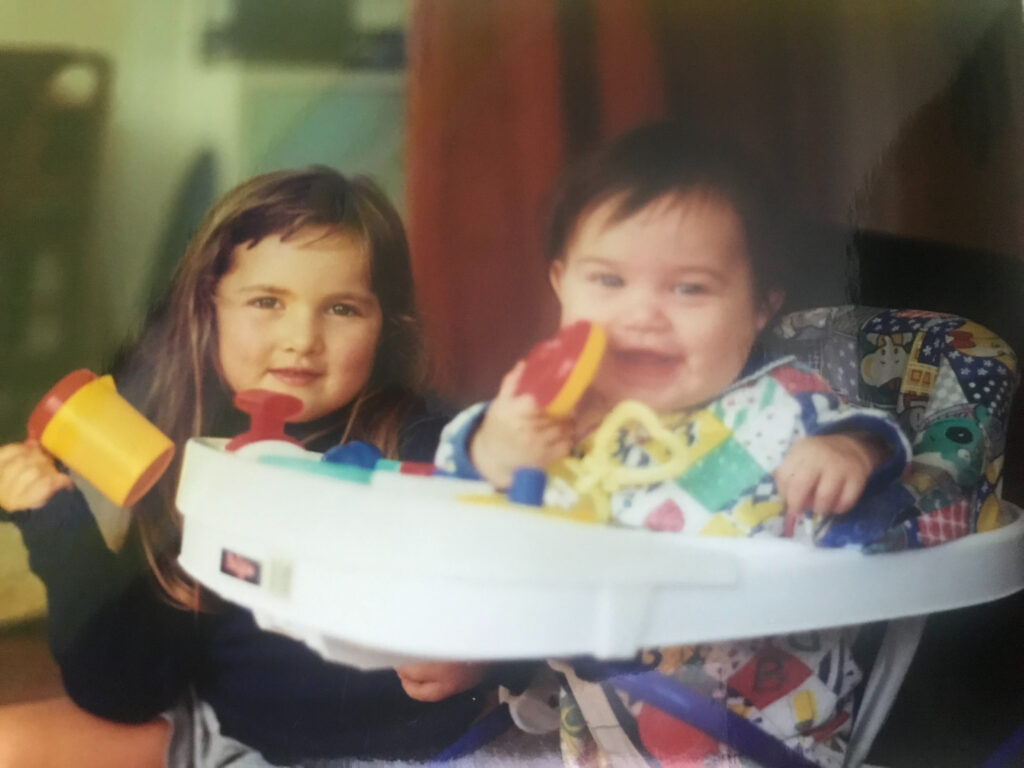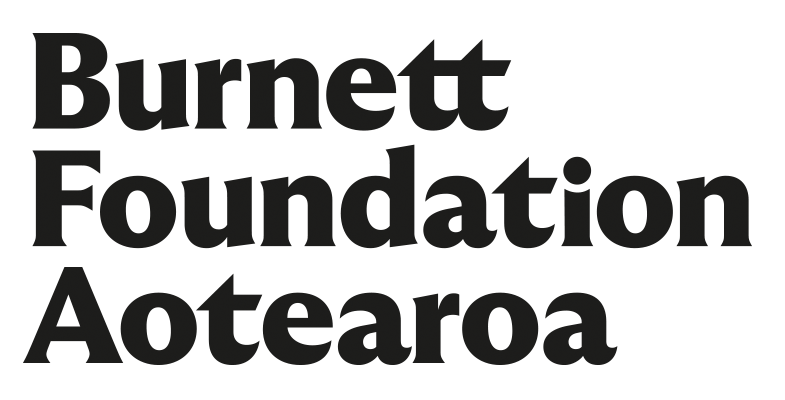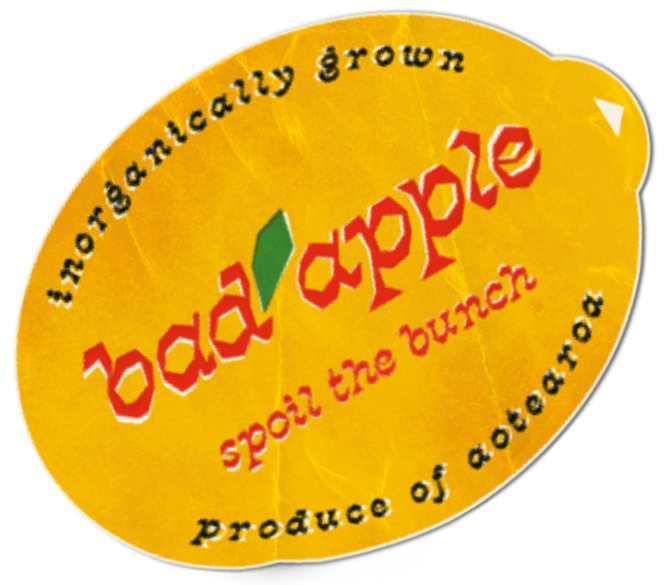remember me in technicolour / I dance on the walls of our house / weave through painted branches / flit through rafters / while tīpuna in kilts and long white dresses / ride horses through the garden / prosperous and lush / we are not static, but vast / and ever-changing / don’t think of as monuments / remember how we laughed
Our wharenui at Rongopai Marae is known as ‘the painted whare’. Instead of carvings, paintings cover the walls. Images of ancestors are depicted amongst a multi-coloured ngahere of trees, leaves and vines.
I’ve always loved our wharenui. As a kid, these images would come to life, a host of ancestors wielding mere, playing cards, collecting roses, while all around painted taniwha would swim through the swirling trees. It was a magical place for a child with an overactive imagination. When I sat in the wharenui and watched, our ancestors would come to life before my eyes.
I see them / unravelling in air / our nannies are mermaids / swimming through the sky / their tails unfurl / arms outstretched / to break the ocean / as they glide / there is water all around you / trees like coral / reach towards the sky / you belong here, e hine / in the puku of your iwi / anei he kāinga mōu
Over time, I’ve come to know my tīpuna better. My cousin tells me stories of pakanga that led us to settle in Waituhi centuries ago. He points out each ridge of the maunga nearby. His words weave images and conjure ancestors long passed.
Through his stories, I can see them—how their bodies moved through space, how cries echoed out across the landscape when loved ones were lost. I can feel their grief. I can understand the deep love they had for one another. I understand where we have come from and how these past lives reverberate through mine.
These histories are all inscribed within our whare. A pair of eyes on a tukutuku panel represent two twins who were killed long ago. An owl perched on a man’s shoulders is a mother, protecting her iwi. A woman in extravagant dress is the first person to bring kūmara to our rohe.
Our people did incredible things and survived atrocities so we can continue our whakapapa. Rongopai is a place where all our tīpuna congregate—the artworks are not just portraits of individuals, but representations of our collective history.
paint me next to the others / their portraits blood and land and sea / my nan alongside me / and my mother / interlinking / add me as a flower on a vine / or a koru on the rafters / leave space for yourselves / we are together all the time / although still worlds apart
I don’t have the best memory. My sister is a stickler for details and can see her memories as entire scenes in her mind. I mostly remember vibes, small details, the colours and the light, a few words that were spoken in a moment. But everything is hazy and blurs into each other. Time and chronology do not exist. Reality melds with dreams, the distant past melds with the present and everything happens at once.
There’s an anxiety attached to the act of remembering that comes from having a grandmother with dementia, taking care of her although she barely knew who I was. A sense that I could be forgotten in a single moment, and therefore, that I could forget anything just as fast.
I do my best to hold onto stories. At a reunion with my cousins, I ask them about our Nan, and what they remember of her. They remind me of the clicking of her walker, the smell of lavender in the bathroom, the afternoons spent playing cards. Her house was filled with photos of all the people she loved—every space on the wall was occupied by aunties, uncles and other relatives. I often wish I had taken the time to ask who they all were, what they were like. All I knew was that they were our people, our whānau. I was too young to be curious about who she was.
remember my laugh / how it was the same as my mother’s / how I liked to knead dough in the sunlight / drink tea in the lounge / exchange gossip / stride knee deep into the ocean / dream about the future you exist in / these small moments / like rocks gathered on the shoreline / become the things you will look back on / when you too / take to these waters / when you walk / where I have walked
Recently, our last great-aunty passed away. She was one of thirteen siblings, including my koro. They grew up in a two-bedroom home next door to the marae. The last time I visited her in that house, she told me stories of when she and my Nan were young. Them as young girls, back from a night of tin-canning, clambering out of the back of a truck. Giggling softly, not wanting to be caught drunk, falling asleep under the tree in the backyard, cracking jokes and laughing with each other.
This is a different Nan from the one I knew. This version of her is more like myself and my sister, as we are today, and less like the kuia Nan was by the time I was born. My perception of her becomes multi-dimensional. She becomes not just a Nan, but a full human being, at all ages.
We often remember our tīpuna as their biggest achievements. They become larger than life. Stories we tell reduce them to a few key events in their lives and they become like gods to us. But what about the times they joked and laughed? What did their daily lives look like? And what did they see when they imagined the future?
remember me in fullness / complex / not just hardships / or photos / but a life full of moments / lived well / of jokes you’ll never know / people passing through my days / seeing all of me / in your imaginings / we have been the same people / over again
I am often trying to find a place for myself within a vast whakapapa where queer stories like mine have been lost. Where do I fit? Were there others like me in the past? Here is where the term takatāpui can be useful. Although often debated, the kupu ‘takatāpui’ gives us something to cling to. A hint at an aspect of whakapapa that’s been widely erased from our collective memories. A sign that it isn’t just us, in the present day. Takatāpuitanga was a way of being that predated European settlement on this whenua. To be takatāpui is to be located within a uniquely queer Māori whakapapa.
How, then, can we remember our takatāpui ancestors if there is barely any trace of them within our pūrākau and oral histories? We are left only to imagine them, to wonder and to hope that our identities won’t be erased too.
Whakapapa is not genealogy, but a layering of connections, one on top of the other, to help understand the origins of everything.
I am coming to realise that I exist as an intermediary between the past and the future. I am not the beginning of anything, but rather a point in a vast continuum of whakapapa that has existed long before me and will continue long after I am gone. As such, I am connected to all who came before me and all who will come after me. I am held secure in this web of whakapapa. I am contextualised. In the words of Hana Burgess:
“The present is this fleeting moment of past and future generations meetings. It’s not the pinnacle of our existence . . . but in that meeting of past and future generations, we have a window of agency where we can lay down whakapapa and shape the future.”
I spend a lot of time considering how I might continue to shape the future of this whakapapa. I am re-learning te reo Māori, I am re-building relationships with my tīpuna and I am trying to connect with ways of being takatāpui that existed long before colonisation. These are not new things that have started with me, they are old threads that I am picking up. I’m weaving them back into the fabric of my whakapapa.
It is widely known that takatāpui were erased from our histories with the impacts of colonisation and the introduction of Western values into our communities. I often wonder how many stories were lost in the massacres of Māori that took place all over the country and in the mass deaths caused by illness. I wonder how many takatāpui experiences were erased from our histories due to the introduction of Christianity and the re-interpreting of stories to fit within a Christian perspective of ‘good vs evil’.
I know that when I stretch outwards, when I reach far enough into whakapapa, I can find others like me. In the expansive webs of whakapapa, I search for them. I am aware that there are others like me. In the past, in the future, in the present.
in the before times / we were villages / and there was space for us / we flowed back and forth together / and were known / safe on this island paradise / I sing for you, back then / still, you still remember the tune
To be takatāpui in the continuum of whakapapa is powerful. It means that any choice to continue my whakapapa must be purposeful and deliberate. My own identity as a tīpuna takatāpui must be a part of the story they tell.
I want to be remembered in my queerness, for the lost threads of takatāpuitanga to be woven back into our whakapapa, and for it to be spoken about. I want to hang in a picture frame with my darling, or for us to be painted together in my wharenui. For us to be visible, remembered.
I see myself as a part of a continuous whakapapa, as a point within a matrix of complex relationships that span backwards and forwards in time simultaneously. Therefore, everything I aim to reclaim during my lifetime does not make me ‘the first’. I am on my te reo journey, a whakapapa journey, a journey to reclaim pūrākau and mātauranga, but I am not the first, nor do I call this ‘learning’. It is an act of re-learning, of remembering, of re-vitalising things that were once thriving. An act of whaka-rau-ora, of re-germinating ora or life.
As such, the threads of takatāpui cannot be new. They have origins as far back as te kore. We are simply re-connecting, re-viving, re-membering how to love like this.
you coax me out of the darkness / your sunshine sets the world alight / fingers peel my petals to the ground / I have been here before / but in every iteration / an empty longing / a vast cavern opening up / but this is a moment / so much a moment that we wonder / why no one’s written about us yet
We are all mokopuna and tīpuna simultaneously. We exist in all dimensions all the time. As ancestors, my partner and I are already making decisions for our uri even before they are born. We list their names. We make plans in preparation for their arrival. We do the work we need to do to provide the best possible care for them once they eventually come into this world.
There is only so much preparation you can do. In the end, I want to be an ancestor who nurtures, who laughs and loves, and who always shows my care for my tamariki and mokopuna. I want to be an ancestor who does no harm, one who helps heal the intergenerational wounds in our whakapapa.
I want to be ever-present, multidimensional and human in the memories of my descendants. To be joyously queer, and for that to be a part of the story they tell.
here, in paradise, everyone is alive and dancing / the vivid greens and pinks and sequins / someone is playing the piano / while a lithe themme leans against it / fresh flowers from the audience / the red, red roses, daffodils / the world glittering, too bright to look at / bellowing laughs / coz there’s no such thing as violence here / and no possibility of dying / there’s just the endless charge of celebration / as we glow in radiant spheres / knowing we are the stars those left on earth peer up to / full of wishes & in awe.

Featured photos supplied.
This work has been made possible thanks to financial support from Burnett Foundation Aoteaora.




